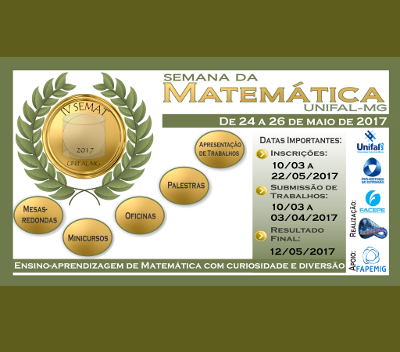O uso de derivada fracionária na descrição do decaimento não exponencial
Keywords:
Nonexponential decay, fractional calculus, Mittag-Leffer functionAbstract
In a radioactive decay, the amount of unstable species that remains at time t is given by a differential equation with integer order, known as exponential law. Currently, there are evidence of nonexponential nuclear decay at long time, when the number of species present decays slowly such as $1/t^{n}$. The objective of this work was to consider a generalized differential equation with noninteger order, it was able to describe the experimental data in both regions: exponential and nonexponential region. This behavior, obtained by fractional calculus, in agreement withrecent experimental data in the literature.
References
Ç ALIK, A. E.; ERTIK, H.; ODER, B.; SIRIN, H. A fractional calculus approach to investigate ¨ the alpha decay process. Int. J. Mod. Phys. E v.22, n.7, 145-157. 2013.
ASTON, P. J. Is radioactive decay really exponential? EPL v.97, p. 52001, 2012.
ASTON, P. J. Reply to the comment by Cleanthes A. Nicolaides. EPL v. 101, p. 42002, 2013.
AVIGNONE, F. T.; Comment on ’Test of the experimental decay law at short and long times’. Phys. Rev. Lett. v. 61, n. 22, p. 2264, 1988.
DOKOUMETZIDIS, A.; MACHERAS, P. Fractional kinetics in drug absortion an disposition process. J. Pahrmacokinet Pharmacodyn v. 36, p. 165-178, 2009.
GAMOW, G. Zur quantentheorie des atomkernes. Z. Phys. v. 51, n. 3(4), p. 204-212, 1928.
GODOVIKOV, S. K. Nonexponential 125mTe radiactive decay. JETP Letters v. 79, n. 5, p. 249-253, 2004.
KELKAR, N.G.; NOWAKOWSKI, M.; KHEMCHANDANI, K.P. Hidden evidence of nonexponencial nuclear decay. Phys. Rev. C, v. 70, p. 024601, 2004.
MAINARDI, F. On some properties of the Mittag-Leffer function Eα(−t α) completely monotone for t > 0 with 0 < α < 1. 2013. URL arXiv:1305.0161v1[math-ph]1May2013.
MERZBACHER, E. Quantum Mechanics. New York: John Wiley, 621p, 1961.
NICOLAIDES, C. A. Comments on ’Is radiactive decay really exponential?’ EPL v. 101, p. 42001, 2013.
NORMAN, E. B.; GAZES, S. B.; CRANE, S. G. ; BENNETT, D. A. Test of the experimental decay law at short and long times. Phys. Rev. Lett. v. 60, n. 22, p. 2246–2249, 1988.
NOVKOVIC, D.; NADDERD, L.; KANDIC, A.; VUKANAC, I.; DURASEVIC, M.; JORDANOV, D. Testing the exponential decay law of gold 198Au. Nucl. Instr. and Meth. A v. 446, p. 477-480, 2006.
PERES, A. Nonexponential decay law. Ann. Phys. v. 129, n. 1, p. 33–46, 1980.
PODLUBNY, I., Rotina do MATLAB para calcular a função de Mittag-Leffler com a acurácia desejada. Disponível em: http://www.mathworks.com/matlabcentral/fileexchange/8738-mittag-leffler-function. Acesso em: 13 fev. 2013.
POOSEH, S.; RODRIGUES, H. S.; TORRES, D. F. M. Fractional derivatives in Dengue epidemics. 2011. URL arXiv:1108.1683v1[math-CA]8Aug2011.
RIDA, S. Z.; EL-SAYED, A. M. A.; ARAFA, A . A. M. Effect of bacterial memory dependent growth by using fractional derivatives reaction-diffusion chemotactic model. J. Stat. Phys., v. 140, p. 797–811, 2010.
RUTHERFORD, E. Uranium radiation and the electrical conduction produced by it. Phil. Mag., v. 47, n. 284, p. 109-163, 1899.
dos SANTOS, J. P. C.; CARDOSO, A.; FERREIRA, E. C.; FRANCO, J. C.; SOUZA Jr., J. C. Cálculo de Ordem Fracionária e Aplicações. Sigmae, v.1, n.1, p. 18-32, 2012.
SKOROBOGATOV, G. A.; EREMIN, V. V. On the paper “Nonexponential 125mTe radiactive decay”. JETP Letters v. 83, n. 1, p. 46–48, 2006.
SOBOL, I. M. A primer for the Monte Carlo. London: CRC Press, 107p, 1994.
Downloads
Published
How to Cite
Issue
Section
License
Proposta de Política para Periódicos de Acesso Livre
Autores que publicam nesta revista concordam com os seguintes termos:
- Autores mantém os direitos autorais e concedem à revista o direito de primeira publicação, com o trabalho simultaneamente licenciado sob a Licença Creative Commons Attribution que permite o compartilhamento do trabalho com reconhecimento da autoria e publicação inicial nesta revista.
- Autores têm autorização para assumir contratos adicionais separadamente, para distribuição não-exclusiva da versão do trabalho publicada nesta revista (ex.: publicar em repositório institucional ou como capítulo de livro), com reconhecimento de autoria e publicação inicial nesta revista.
- Autores têm permissão e são estimulados a publicar e distribuir seu trabalho online (ex.: em repositórios institucionais ou na sua página pessoal) a qualquer ponto antes ou durante o processo editorial, já que isso pode gerar alterações produtivas, bem como aumentar o impacto e a citação do trabalho publicado (Veja O Efeito do Acesso Livre).

